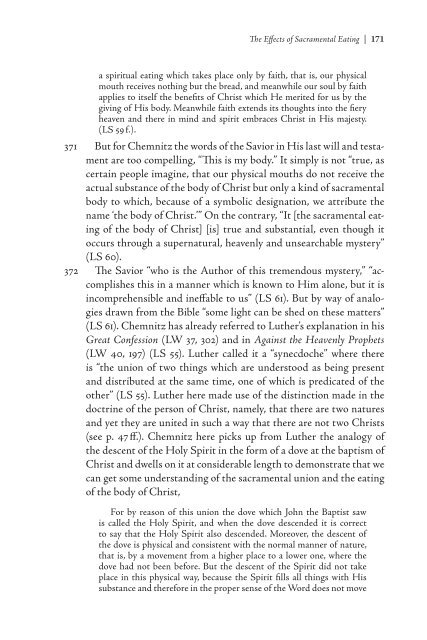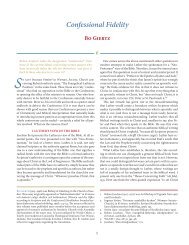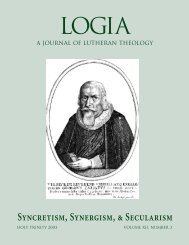The Lord's Supper in the Theology of Martin Chemnitz Bjarne - Logia
The Lord's Supper in the Theology of Martin Chemnitz Bjarne - Logia
The Lord's Supper in the Theology of Martin Chemnitz Bjarne - Logia
Create successful ePaper yourself
Turn your PDF publications into a flip-book with our unique Google optimized e-Paper software.
<strong>The</strong> Effects <strong>of</strong> Sacramental Eat<strong>in</strong>g |<br />
a spiritual eat<strong>in</strong>g which takes place only by faith, that is, our physical<br />
mouth receives noth<strong>in</strong>g but <strong>the</strong> bread, and meanwhile our soul by faith<br />
applies to itself <strong>the</strong> benefits <strong>of</strong> Christ which He merited for us by <strong>the</strong><br />
giv<strong>in</strong>g <strong>of</strong> His body. Meanwhile faith extends its thoughts <strong>in</strong>to <strong>the</strong> fiery<br />
heaven and <strong>the</strong>re <strong>in</strong> m<strong>in</strong>d and spirit embraces Christ <strong>in</strong> His majesty.<br />
(LS 59 f.).<br />
371 But for <strong>Chemnitz</strong> <strong>the</strong> words <strong>of</strong> <strong>the</strong> Savior <strong>in</strong> His last will and testament<br />
are too compell<strong>in</strong>g, “This is my body.” It simply is not “true, as<br />
certa<strong>in</strong> people imag<strong>in</strong>e, that our physical mouths do not receive <strong>the</strong><br />
actual substance <strong>of</strong> <strong>the</strong> body <strong>of</strong> Christ but only a k<strong>in</strong>d <strong>of</strong> sacramental<br />
body to which, because <strong>of</strong> a symbolic designation, we attribute <strong>the</strong><br />
name ‘<strong>the</strong> body <strong>of</strong> Christ.’” On <strong>the</strong> contrary, “It [<strong>the</strong> sacramental eat<strong>in</strong>g<br />
<strong>of</strong> <strong>the</strong> body <strong>of</strong> Christ] [is] true and substantial, even though it<br />
occurs through a supernatural, heavenly and unsearchable mystery”<br />
(LS 60).<br />
372 <strong>The</strong> Savior “who is <strong>the</strong> Author <strong>of</strong> this tremendous mystery,” “accomplishes<br />
this <strong>in</strong> a manner which is known to Him alone, but it is<br />
<strong>in</strong>comprehensible and <strong>in</strong>effable to us” (LS 61). But by way <strong>of</strong> analogies<br />
drawn from <strong>the</strong> Bible “some light can be shed on <strong>the</strong>se matters”<br />
(LS 61). <strong>Chemnitz</strong> has already referred to Lu<strong>the</strong>r’s explanation <strong>in</strong> his<br />
Great Confession (LW 37, 302) and <strong>in</strong> Aga<strong>in</strong>st <strong>the</strong> Heavenly Prophets<br />
(LW 40, 197) (LS 55). Lu<strong>the</strong>r called it a “synecdoche” where <strong>the</strong>re<br />
is “<strong>the</strong> union <strong>of</strong> two th<strong>in</strong>gs which are understood as be<strong>in</strong>g present<br />
and distributed at <strong>the</strong> same time, one <strong>of</strong> which is predicated <strong>of</strong> <strong>the</strong><br />
o<strong>the</strong>r” (LS 55). Lu<strong>the</strong>r here made use <strong>of</strong> <strong>the</strong> dist<strong>in</strong>ction made <strong>in</strong> <strong>the</strong><br />
doctr<strong>in</strong>e <strong>of</strong> <strong>the</strong> person <strong>of</strong> Christ, namely, that <strong>the</strong>re are two natures<br />
and yet <strong>the</strong>y are united <strong>in</strong> such a way that <strong>the</strong>re are not two Christs<br />
(see p. 47 ff.). <strong>Chemnitz</strong> here picks up from Lu<strong>the</strong>r <strong>the</strong> analogy <strong>of</strong><br />
<strong>the</strong> descent <strong>of</strong> <strong>the</strong> Holy Spirit <strong>in</strong> <strong>the</strong> form <strong>of</strong> a dove at <strong>the</strong> baptism <strong>of</strong><br />
Christ and dwells on it at considerable length to demonstrate that we<br />
can get some understand<strong>in</strong>g <strong>of</strong> <strong>the</strong> sacramental union and <strong>the</strong> eat<strong>in</strong>g<br />
<strong>of</strong> <strong>the</strong> body <strong>of</strong> Christ,<br />
For by reason <strong>of</strong> this union <strong>the</strong> dove which John <strong>the</strong> Baptist saw<br />
is called <strong>the</strong> Holy Spirit, and when <strong>the</strong> dove descended it is correct<br />
to say that <strong>the</strong> Holy Spirit also descended. Moreover, <strong>the</strong> descent <strong>of</strong><br />
<strong>the</strong> dove is physical and consistent with <strong>the</strong> normal manner <strong>of</strong> nature,<br />
that is, by a movement from a higher place to a lower one, where <strong>the</strong><br />
dove had not been before. But <strong>the</strong> descent <strong>of</strong> <strong>the</strong> Spirit did not take<br />
place <strong>in</strong> this physical way, because <strong>the</strong> Spirit fills all th<strong>in</strong>gs with His<br />
substance and <strong>the</strong>refore <strong>in</strong> <strong>the</strong> proper sense <strong>of</strong> <strong>the</strong> Word does not move




